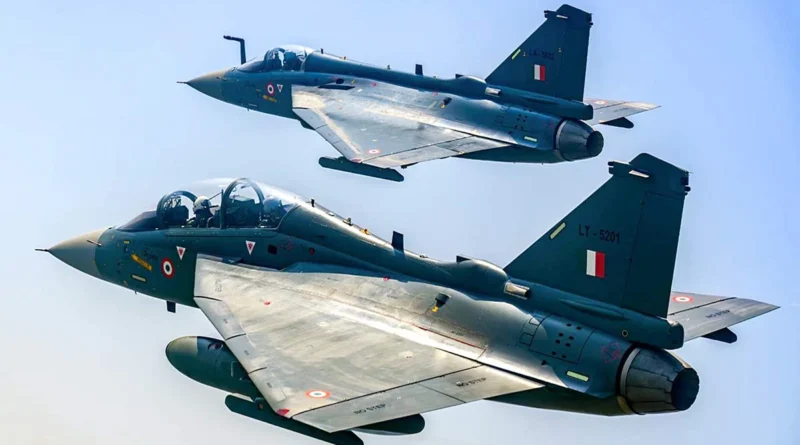Tejas Deal and ₹69,725 Cr Maritime Boost Signal Strategic Shift Towards Self-Reliant India in Defence
Two major decisions by Prime Minister Narendra Modi, known for his consistent efforts to strengthen India’s armed forces, have sent a clear strategic signal—India is rebalancing South Asia’s power dynamics in its favour.
On one hand, India has signed a historic deal with Hindustan Aeronautics Limited (HAL) for the purchase of 97 Tejas Mk-1A fighter jets, and on the other, it has announced a ₹69,725 crore reform package for shipbuilding and maritime infrastructure. Together, these steps are poised to take India’s defence self-reliance and strategic autonomy to new heights.
Strategic Significance of the Tejas Deal
This is the largest-ever indigenous fighter aircraft deal. Earlier in February 2021, India signed a ₹46,898 crore contract for 83 Tejas Mk-1A aircraft, scheduled for delivery between 2024 and 2028.
The new deal includes:
- 68 single-seat fighters and
- 29 trainer aircraft,
featuring advanced systems like UTTAM AESA radar, indigenous electronic warfare suites, and locally developed actuator controls, with over 64% indigenous content.
This agreement comes just as the retirement of the ageing MiG-21 fleet looms, making it crucial for maintaining the operational capability of the Indian Air Force (IAF). At present, the IAF has only 29 squadrons, well below the sanctioned strength of 42.5, while Pakistan has 25 squadrons and China has nearly four times more.
The Tejas order isn’t merely about numbers—it’s a long-term investment in indigenous air power. Complementing this is a deal with General Electric (GE) for 113 F-404 engines, ensuring a stable production line. HAL has also promised to increase annual production from 20 to 24–30 aircraft, helping the IAF close its squadron gap.
Shipbuilding and Maritime Infrastructure Reform
Equally significant is the ₹69,725 crore reform package to boost India’s shipbuilding sector—dubbed the “Mother of Heavy Engineering.” This will not only expand India’s shipbuilding capacity but also safeguard energy, food, and strategic supply chains.
It marks the first time since independence that a government has made such a massive investment in shipbuilding. The plan is built around four key pillars:
- Shipbuilding Financial Assistance Scheme (SBFAS) – ₹24,736 crore in assistance until 2036
- Maritime Development Fund – ₹25,000 crore (₹20,000 crore investment fund + ₹5,000 crore interest support)
- Shipbuilding Development Scheme – ₹19,989 crore to scale capacity to 4.5 million gross tonnage
- Legal and policy reforms – includes setting up large shipbuilding clusters, insurance support, and a new India Ship Technology Centre
The initiative is projected to generate 3 million jobs and attract ₹4.5 lakh crore in investment. It will also boost India’s capability to build indigenous warships and supply vessels for the Navy.
Boosting Self-Reliance and Regional Power Balance
Combined, both initiatives represent a bold leap in India’s defence self-sufficiency. The Tejas deal sends a clear message—India won’t rely entirely on foreign imports for its air power. While some foreign support remains necessary (e.g., for engines and advanced systems), the country is steadily increasing its indigenous capabilities.
Meanwhile, the maritime push will strengthen India’s strategic presence in the Indian Ocean Region (IOR), where China’s “String of Pearls” strategy has led to the construction of naval bases across Sri Lanka, Pakistan, and Africa. To counter this, India must build a strong Blue Water Navy—and the new maritime plans directly support this goal.
Challenges and Opportunities
Despite the promise, the path to Atmanirbharta (self-reliance) isn’t easy. The Tejas project has a history of delays and technical hurdles, and the IAF has repeatedly stressed that capability gaps cannot be tolerated in the name of self-reliance. Timely, high-quality delivery remains the most pressing concern.
Similarly, shipbuilding faces major challenges in terms of capital investment, cutting-edge tech, and global competition. China is already the world’s largest shipbuilder, so India must not only meet domestic needs but also compete globally.
Conclusion
The Tejas deal and the maritime infrastructure package have the potential to be milestones in India’s defence and strategic evolution. These steps will foster job creation, technological innovation, and help establish India as a Net Security Provider in the region.
Although China currently holds the advantage in regional power equations, these decisions could tilt the balance over time, strengthening India’s position and boosting its strategic confidence and autonomy.
In essence, this marks the beginning of a new chapter in India’s defence sector under the vision of ‘Atmanirbhar Bharat’, with its success depending on timely execution and sustained political and strategic will.

